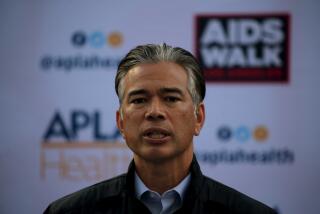Gov. vetoes hospital disclosure
SACRAMENTO â Under pressure from the politically robust hospital industry, Gov. Arnold Schwarzenegger has rebuffed a legislative proposal that could help California catch up with other parts of the nation by allowing patients to learn the safety and surgical success rates of specific hospitals and doctors.
Healthcare experts say that one of the most inexpensive and effective ways to encourage hospitals to improve patient care is to make their failures public. Schwarzenegger has endorsed this approach, saying as recently as March that greater transparency would âdrive healthcare providers to perform at peak levels,â âboost the power of consumer choices,â âsave a lot of moneyâ and âsave a lot of lives.â
But the governor on Friday vetoed a bill passed by the Legislature that contained provisions that would have made it easier for the public to review hospital performance.
The governorâs own healthcare bill, released last week, adopted many sections of the legislative plan. But he omitted or weakened patient-oriented provisions that are objectionable to the California Hospital Assn., one of Sacramentoâs biggest lobbyists and donors.
The proposal does not require the state to release any information to the public, leaving those decisions to the discretion of the governor.
âWithout addressing quality shortfalls, weâre just adding people onto a sinking ship,â said Peter Lee, chief executive of the Pacific Business Group on Health, a coalition of more than 50 large employers. âInstead of putting a stake in the ground, weâre going to issue a report? That is all this requires to be done.â
Kimberly Belshe, Schwarzeneggerâs secretary for health and human services, defended his proposal Thursday, saying it struck the right âbalanceâ and would go âfar beyond what the state has done so far.â
More than two decades after the state started collecting data from hospitals, the stateâs performance continues to be less than inspiring. California has issued studies on how hospitals handle just two conditions -- heart attacks and pneumonia -- and one operation -- coronary artery bypass grafts -- even though a 1980s law requires the state to complete at least nine reports each year.
The few studies that are released become obsolete quickly. When the bypass report was published in July, its data were already 3 years old. The stateâs latest pneumonia report relies on 2004 information, and the most recent heart attack data are from 1998.
âThe record is dismal,â said Dr. Robert Brook, a UCLA professor of medicine who sits on a panel that advises the state on putting together its studies. âAll the ice in the Arctic will have melted before we have a real transparent system in California unless we really change what weâre doing.â
Other states, including New Jersey, Kentucky, Missouri and Maryland, are doing more. Last month, New York City began releasing annual infection and death rates at the cityâs 11 public hospitals.
Healthcare experts say Pennsylvania does the best job, reporting each year how effectively its hospitals treat 19 common ailments, including blood clots, heart and kidney failure and strokes. Pennsylvania also publishes data showing how well its hospitals repaired hip fractures, unblocked seized-up hearts and performed 10 other procedures.
California is particularly far behind other states in compelling hospitals to reveal how likely patients are to contract an infection while in a hospital. Prodded by Consumers Union, a nonprofit advocacy group, lawmakers in 19 other states have mandated that hospitals release that data.
Federal officials estimate that healthcare-associated infections lead to 99,000 deaths each year, making them one of the biggest killers in the United States. Infections have grown so costly to Medicare, the nationâs insurance program for the elderly, that starting next year the government will cease reimbursing hospitals for the cost of treating infections that patients pick up there.
Infections acquired at California hospitals, nursing homes and similar institutions cost $3.1 billion to treat, according to a state estimate. In 2006, a bacterial outbreak forced White Memorial Medical Center in East Los Angeles to close its neonatal and pediatric intensive care units to new admissions for two weeks; at least seven children were infected, including one baby who died.
âIt doesnât make any difference what hospital you walk into, theyâre all very dirty,â said Christine Cahill, a retired state infection control investigator who is now a private consultant. âYou go into a restaurant and you find tougher regulations in the kitchen than you doâ in hospitals.
Few patients are aware of the dangers. Actress Alicia Cole contracted a deadly flesh-eating bacterium that began devouring her abdomen shortly after she underwent surgery at Providence Saint Joseph Medical Center in Burbank in 2006.
âOne of the nurses pulled my parents inside a room, closed the door and said, âsomething is wrong here,â â Cole said. The 45-year-old from Sherman Oaks is still recovering from the illness.
The hospital declined to discuss her case, but said no other patients contracted necrotizing fasciitis, the infection that attacked Cole. Spokesman Dan Boyle said the hospitalâs infection rates are below the national average. The hospital would not provide actual figures and is not required to make them public.
Californiaâs hospital lobby has not supported aggressive public reporting of infection rates. The association is a dominant presence in the Capitol, spending $2.9 million on lobbying during the 2005-06 legislative session and giving $680,713 to candidates for office.
C. Duane Dauner, president of the stateâs hospital association, said he supports transparency if rates are accurate and their public reporting does not âopen the institutions up for nonmeritorious and frivolous lawsuitsâ or discourage employees from reporting infection dangers.
âWe in no way intend to be obstructionist,â Dauner said. âWe just want to have fair reporting for the hospitals and not unduly scare patients in their communities.â
But the hospital association opposed the Legislatureâs last attempt to reveal contagion rates, saying they feared hospitals would be blamed for infections patients contracted before being admitted. Lawmakers overrode those objections by approving a bill in 2004 to take community infections into account. But Schwarzenegger, whose re-election campaign last year received $44,600 from the hospital association -- the maximum allowed by law -- vetoed the measure.
Two years later, a more modest approach backed by the hospitals won Schwarzeneggerâs signature. It requires hospitals to tell the state how dutifully staffers use sterile methods to insert catheters and administer antibiotics before surgery, techniques recommended by federal health authorities to help ward off infections.
But the administration has not made this a priority. In August, Schwarzenegger, needing to balance the state budget, stripped out the $1.3 million legislators provided to set up the program.
Even if it does launch, patient advocates and healthcare experts consider these kinds of measurements inferior to data that show whether patients were protected from infections. In fact, Consumers Union considered the 2006 bill so weak that it ultimately opposed it.
Patient advocates and employer groups were hopeful lawmakers would include a stronger measure in this yearâs healthcare deliberations. But the hospitalsâ political position turned out to be even stronger than usual, because Schwarzenegger needs their support for his $14-billion plan to expand medical insurance to nearly all Californians. His plan relies on a $2.3-billion tax on hospital revenues, which would be all but impossible to pass if the industry opposes it.
Last month, Daunerâs association endorsed Schwarzeneggerâs plan, but said hospital backing was contingent on transparency provisions that were âreasonable, valid and meaningful.â
The transparency language included in the Legislatureâs healthcare bill did not meet the hospitalsâ test. Modeled on Pennsylvaniaâs approach, it would have created an independent transparency commission that could decide what information to publicize, order healthcare facilities to provide data and charge them for the costs of administering the stateâs transparency efforts.
The panel would have been dominated by people outside the healthcare industry, representing consumers, companies and employees, all of whom have a vested interest in reducing the cost of care. And the panel would have been required to publish infection rates at individual hospitals by the middle of 2010.
The governorâs plan reduced the panelâs role to an advisory one, requiring it only to submit recommendations to the Schwarzenegger administration, which would decide what actions, if any, to take.
Even as the debate continues in Sacramento, one California hospital is embracing a more transparent approach.
In 2005, Pacific Hospital of Long Beach launched a campaign to install ultraviolet lights in the ventilation systems and require the routine washing of admitted patients from head to toe with a chemical that acidifies the skin to kill germs they bring in.
The hospital also began posting its infection rate on its website. According to the hospital, seven patients out of every 10,000 last year were infected -- one-sixth of the national average as calculated by the federal Centers for Disease Control and Prevention.
âHospitals are afraid that they will lose some prestige,â said Dr. Alfonso Torress-Cook, an epidemiologist at the hospital. âWe went ahead and said âthis is who we are. Mistakes are made because we are human, but we are striving for perfection.â â
--
More to Read
Get the L.A. Times Politics newsletter
Deeply reported insights into legislation, politics and policy from Sacramento, Washington and beyond. In your inbox three times per week.
You may occasionally receive promotional content from the Los Angeles Times.










